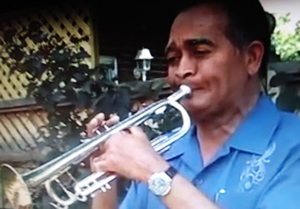Kesnel Hall was among the best trumpet players of the fifties in Haiti when our jewel, Haiti, enjoyed the flowering and exuberance of its melodies. However, he never received the attention or honor he deserved. Our elders underlined in a few interviews that he exhibited himself in the shadow of Hilario Dorval, Raymond Sicot, Serge Lebon or an Alphonse Simon (Chico) for years. Therefore, his breakthrough at the pinnacle of such a competitive line proved impossible. Yet he was a good reader who easily decoded musical symbols and was regulated like music paper, stammered Dr Charles Dessalines in an interview (Nov 2008). His mastery of the mouth, the flexibility of his lips and his breathing facilitated the sublimation of his renditions. What’s more, this velvet-lipped trumpet player received his instructions from Augustin Bruno and Myrthil Anson. This ability imbibed in him by these two music enthusiasts allowed him to fulfill the role of ‘Emergency Trumpetist in the Youth Jazz at the International Casino in 1962 at times when the flagship of our folklore was in immediate need. From time to time, his services were also requested by other orchestras in the capital as well as that of Perez Prado during his two-week stay in Haiti. He exhibited his talents as a good reader or scholar in music with the Orchestra of Perez Prado at Cabane Choucoune, at the Théatre De Verdure and at the Rex Théatre playing the role of fourth trumpet player. Kesnel was, like a whole myriad of our musicians, a product of the Maison Centrale Des Arts Et Métiers. He was never ashamed to refer to his alma mater, like so many of his colleagues who were beneficiaries of the enriching experience of this institution. From this training center, how many negative feelings or gossip formulated by some detractors about this building!
Born of Haitian parents in Santa Clara, a city of Cuba, province of Oriente, on November 26, 1926, his mother, Lucia Jean Bart, originally from the south, moved to the city of Cayes, Haiti, with him in 1937. His father, Arsène who fulfilled the function of team leader in a sugar factory, remained in Cuba with Marthe, one of his daughters. Note that Arsène and Lucia had five children, Felina, Julia, Marthe, Flavien and Kesnel. However, Kesnel found it difficult to integrate into the Cayenne life which was for him a bit dark and monotonous, despite the dedication of his paternal grandfather, Albert, a music enthusiast who brought him from time to time to sessions. training of a musical group from Les Cayes whose name escapes Doctor Dessalines. On the other hand, to alleviate the situation, his mother changed her environment. Returned to Port-au-Pince in 1939, the young Kesnel was admitted to the vocational school ‘Centrale Des Arts Et Métiers’ at the age of 13 where he learned to handle Augustin Bruno’s cornet and the trade of tailor of Félix Isidor. Already at the age of 20, he was selected by Charles Ménard Paul, one of his classmates, to replace him in Les Gais Trouvères in 1946. In 1947, Ulysse Cabral integrated him into the first formation of the group ‘Les Gais Troubadours ‘and performed alongside Michel Desgrottes, Dieuveuil Dugué, as trumpet players, Joe Trouillot and Ulysse Cabral as singers, Gaston Madeère, bassist, Maurice Morisset, drums and André Désrosiers, bongo. Unfortunately, the recordings or archives of this group were burned when a terrible fire consumed the HH2S radio station which sat at the corner of rue du centrre and the cobbled street a few meters from the Saint Louis De Gonzagues institution. Until after Les Gais Troubadours, he joined the Cojunto Citadelle, which in a few months changed its status from Cojunto Citadelle to Orchester Citadelle under the direction of René Diogène in 1948. Then, it was the Atomic Orchestra whose founder was Nemour Jean Baptiste .
Having burned politeness to the maestro, founder, the members of the group entrusted the direction to the pianist Robert Camille. Assisted by Kesnel Hall, Walther Thadal, Max Pierrot, William Charles in the brass section, André Désrouleaux, Antoine Osselin, Monfort Jean Baptiste in the rhythm section and Joe Lavaux as singer; Nemour was excluded from the musical group. Helped, it is said, by Issah El Saieh, he set up Atomique Junior which has not stood the test of time. Our interviews with several of our elders suggest that L’Orchestre Atomique under the direction of Robert Camille will shine until 1956 in Haiti as well as in the other Antilles. Become a member of the NoNo Lami Orchestra in 1956 which exhibited at Cabane Choucune under the direction of Joe Trouillot (Joseph André), However, because of the disappointing, revolting salary that Madamme Marini paid to the musicians, Kesner Hall, in collusion with the other musicians entered into collusion with Joe Trouillot with a view to requesting a contract from the management of the International Casino. Request approved, therefore, after signing the contract, the Orchester Choucone or Orchester Lami adopted the name “Orchester du Casino International”. A few months later, the Casino International orchestra left for Italy where the famous inspiration of Joe Trouillot ‘Oro Baso’ emanated; although some musical phrases belong to the song ‘Mwen di w wi w di mwen non’. According to the words of Dr Charles Dessalines and Joe Trouillot the Orchestra brought honor to the country. It was only after Francois Duvalier’s investiture on September 22, 1957 that the Casino orchestra returned there. Having touched his native soil on October 22, 1957, Maestro Joe Trouillot set to work to captivate his audience by writing Nan Casino, Oro Baso and other new compositions. Having tasted the splendid and majestic accomodations of the countries of Europe, Joe aspired to visit other continents and explore other openings more fascinating than those of Haiti. After he had visited Europe with the orchestra, Carlo Dorléans Juste du Perchoir d’Haiti in Montreal offered him a contract which he accepted. On the other hand, before his departure for North America (Canada), together with the management of the Casino, Joe entrusted the role of maestro to Kesner Hall and Kenel Diroseau. Unable to agree not to agree, a mouthful between the two maestros forced the management of the Casino to assign the role of director to Kenel Duroseau. In the middle of 1960, Hall went to Martinique to honor a nine-month contract. Returned to the country in 1961, he applied for his position as trumpeter in the management of the Casino and his request was approved.
In 1963, Hall, Féfé Guignard Fritz Pierre and other musicians went to Martinique. With his trumpet, he strolled in several orchestras of the Antilles, especially ‘Tropicana A La Bananeraie under the direction of Félix Guignad and Michel Desgrottes. Are printed on the labels ‘Maison Des Méringues’ Tropicana volume 1, 2, 3, 4, Tropicana (reference 009) and on the direction of Michel Desgrottes, he contributed to the production of the record ‘Michel Desgrottes’ labels Antibo reference (MAR 100). During his stay, he participated in the recording of several other records. He was still living in Martinique during the first two months of 1967. However, at the end of February, he received an invitation from the former Orchester Du Riviera Hotel singer, Jean Benjamin, who was playing in Montreal, Canada. . Arrived in Montreal, he stayed for a good number of times with his friend and former maestro, Joseph André alias Joe Trouillot. He became part of a quartet, with Jean Benjamin, Agar and Thony Toussaint, who interpreted or performed musical pieces in a restaurant theater called El Paso. Almost six months later, the Jean Benjamin Quartet found a job at Chomedey Inn in Laval, Montreal. Kesner Hall performed well in Columbia Cumbia, which was awarded a six-month contract at La Ronde ‘Expos Montreal in 1969. Until then, he partnered with bassist, pianist, Léopold Molière (Yoyo Lavache) of the As de Pétion Ville. He worked for more than five years with the children of saxophonist Victor Flambert of whom Philippe Flambert was the saxophonist maestro and Joe Trouillot, singer etc. This last, accompanied by Philippe Flambert in an interview on Moman Kreyol, the tropical quintet, in 1997 praised Kesner Hall. Joe Trouillot told the Kébreau / Berthaud duo in this interview that Kesner Hall is an exceptional trumpet player who puts his mood, his great expressiveness through melodies that have become famous. Let us cite as examples’ Yes Madamme, the Dead Leaves, Tornade in Soriento, Oro Baso etc. Having had music in all the fibers of his heart, he founded Express Combo with Charles Dessalines, Joe Trouillot, Jean Claude Mathelier etc. Subsequently, he associated himself with several Latin orchestras and with ‘La Nouvelle Vague’ by the author of Nanotte and Deux Guidons, Jean Sejour in 1979-1980, With this group, he recorded a disc which bears the name of group with Jacques Vertus, Toto Toussaint, Félix De La Cruz, Affected for a long time by a weakening or degradation of renal function, Kesner Hall, one of the last musicians of the golden era of Haitian music, the last trumpet player of his generation, bade us farewell on June 17, 2017 at Pierre Boucher Hospital in Montreal. He was a musician who possessed extensive knowledge of multiple instruments including the human voice. Félix and Edner Guignard report that he had three children when he lived in Haiti; two boys and a girl. Until now, his musical works have remained unknown to the general public. He walked with his trumpet and trombone from the ‘Maison Centrale Des Arts et Métiers’ which sat in Fort Saint Clair to North America to alleviate the daily stress. Michel Préssoir will no longer need to call him on the phone to wish him a happy birthday next November; instead, he would have a requiem mass sung in honor of this famous musician with whom he played in the Casno International and Riverside Orchestra of Haiti. Kesnel preceded us all to the other side of life. Our sympathies to the grieving families. May his soul rest eternally in peace.
Adrien B. Berthaud

